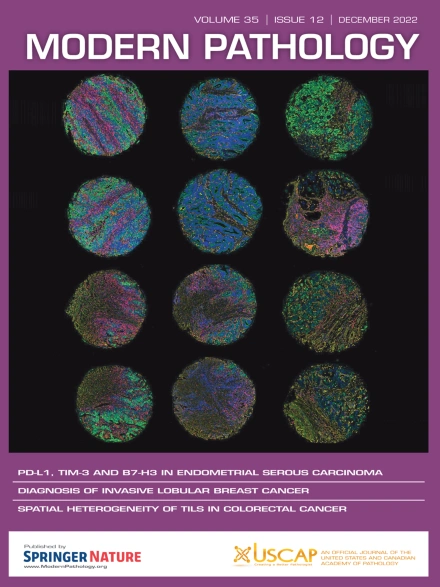Impact of Hormone Receptor Status and HER2 Expression on Neoadjuvant Targeted Therapy Response in HER2-Positive Breast Cancer: A Multicenter Retrospective Study
IF 7.1
1区 医学
Q1 PATHOLOGY
引用次数: 0
Abstract
Previous studies indicate that HER2 protein expression and hormone receptor (HoR) status affect the sensitivity of HER2-positive breast cancer to neoadjuvant therapy, but it is unclear if sensitivity varies among subgroups defined by HER2 and HoR status. We examined 2 cohorts of patients, aged 18 to 80 years, with HER2-positive early breast cancer who underwent neoadjuvant therapy followed by surgery between January 1, 2009, and December 31, 2022: cohort 1 included 2648 patients, and cohort 2 had 141 patients with RNA expression data. Patients were divided into 4 groups based on immunohistochemical HER2 and HoR status: HER2(3+)/HoR−, HER2(3+)/HoR+, HER2(2+)/HoR−, and HER2(2+)/HoR+. We evaluated total pathological complete response (TpCR, defined as ypT0/is ypN0) rates, disease-free survival (DFS), and variations in PAM50 intrinsic subtypes across different subgroups. In cohort 1, HER2(3+)/HoR− had a higher TpCR rate (44.5%) than HER2(3+)/HoR+ (33.8%) (P < .001), HER2(2+)/HoR− (31.7%) (P = .013), and HER2(2+)/HoR+ (13.8%) (P < .001). DFS was similar across groups (P = .445). Trastuzumab or trastuzumab plus pertuzumab significantly improved TpCR rates and DFS in HER2(3+)/HoR− and HER2(3+)/HoR+ but not in HER2(2+)/HoR− and HER2(2+)/HoR+. Cohort 2 showed significant PAM50 subtype differences across these groups (P < .001). In conclusion, the responsiveness of HER2-positive breast cancer to neoadjuvant targeted therapy is significantly influenced by HER2 expression levels and HoR status, emphasizing the necessity of precision medicine approaches to tailor therapeutic strategies for improved clinical outcomes.
激素受体状态和HER2表达对HER2阳性乳腺癌新辅助靶向治疗反应的影响:一项多中心回顾性研究
先前的研究表明,HER2蛋白表达和激素受体(HoR)状态影响HER2阳性乳腺癌对新辅助治疗的敏感性,但目前尚不清楚HER2和HoR状态定义的亚组之间的敏感性是否存在差异。我们对2009年1月1日至2022年12月31日期间接受新辅助治疗和手术的her2阳性早期乳腺癌患者进行了两组研究,年龄在18岁至80岁之间:队列1包括2648例患者,队列2有141例患者的RNA表达数据。根据免疫组化HER2和HoR状态将患者分为4组:HER2(3+)/HoR−、HER2(3+)/HoR+、HER2(2+)/HoR−和HER2(2+)/HoR+。我们评估了总病理完全缓解(TpCR,定义为ypT0/is ypN0)率、无病生存(DFS)和PAM50内在亚型在不同亚组中的变化。在队列1中,HER2(3+)/HoR -的TpCR率(44.5%)高于HER2(3+)/HoR+ (33.8%) (P <;措施),HER2−斯(2 +)/小时(31.7%)(P = .013),和HER2(2 +) /小时+ (13.8%)(P & lt;措施)。各组间DFS相似(P = .445)。曲妥珠单抗或曲妥珠单抗联合帕妥珠单抗显著改善HER2(3+)/HoR -和HER2(3+)/HoR+的TpCR率和DFS,但在HER2(2+)/HoR -和HER2(2+)/HoR+中没有改善。队列2显示各组间PAM50亚型差异显著(P <;措施)。总之,HER2阳性乳腺癌对新辅助靶向治疗的反应性受HER2表达水平和HoR状态的显著影响,强调了精准医学方法的必要性,以定制治疗策略以改善临床结果。
本文章由计算机程序翻译,如有差异,请以英文原文为准。
求助全文
约1分钟内获得全文
求助全文
来源期刊

Modern Pathology
医学-病理学
CiteScore
14.30
自引率
2.70%
发文量
174
审稿时长
18 days
期刊介绍:
Modern Pathology, an international journal under the ownership of The United States & Canadian Academy of Pathology (USCAP), serves as an authoritative platform for publishing top-tier clinical and translational research studies in pathology.
Original manuscripts are the primary focus of Modern Pathology, complemented by impactful editorials, reviews, and practice guidelines covering all facets of precision diagnostics in human pathology. The journal's scope includes advancements in molecular diagnostics and genomic classifications of diseases, breakthroughs in immune-oncology, computational science, applied bioinformatics, and digital pathology.
 求助内容:
求助内容: 应助结果提醒方式:
应助结果提醒方式:


